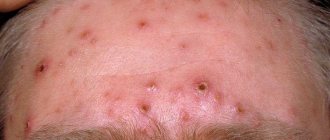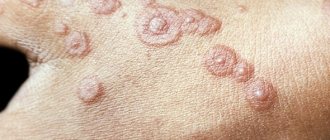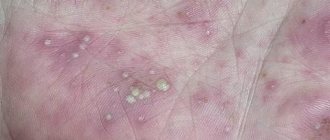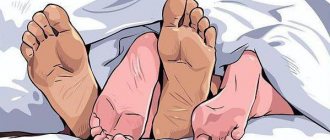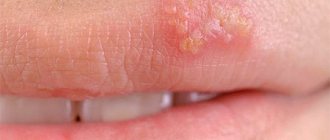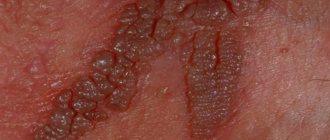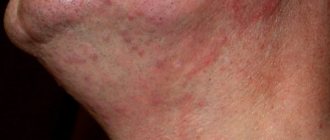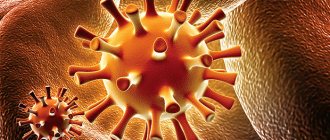Epstein-Barr virus is one of the most common viral infections belonging to the herpesvirus type. Statistics show that about 65% of children and about 98% of adults are infected with this virus. This is easily explained by the fact that this infection is transmitted through coughing, kissing, using household items, through blood, and even from a pregnant woman to her unborn child. The danger of this virus is that it is not always diagnosed due to the absence of any symptoms of infection. People may spend almost their entire lives unaware that they have the Epstein-Barr virus. However, this disease can provoke damage to various tissues and organ systems, so diagnosis should be given special attention.
What it is?
Epstein-Barr virus is transmitted in different ways, but most often infection occurs through saliva. Children can catch type 4 HF:
- through toys and household items;
- during vaccination;
- with injections (especially intravenous);
- when the saliva of an infected person comes into contact with the skin or mucous membranes of a healthy child.
Infectious mononucleosis, a disease caused by the herpes virus type 4, often develops in adults when infected with the herpes virus during kissing. Therefore, the pathological process is also called “kissing disease.”
In addition to contact, there are other ways of transmitting the Epstein-Barr virus:
- fecal-oral;
- contact and household;
- transplantation
As you can see, you can catch this virus under any circumstances and anywhere.
After entering the human body, type 4 GV cells begin to actively divide. Subsequently, they enter the lymph and bloodstream and are distributed throughout the body. Viral variants cause rapid cloning of pathological cells, which subsequently fill the lymph nodes. It is for this reason that adults and children suffering from manifestations of pathological processes caused by type 4 HHV primarily develop lymphadenopathy.
However, as noted earlier, the entry of the Epstein-Barr virus into the blood does not always guarantee the development of the disease. The main predisposing factor to the appearance of characteristic symptoms is a significant weakening of the immune system of the infected person. This can happen when:
- hypothermia;
- uncontrolled or prolonged use of antibacterial drugs;
- frequent colds;
- severe stress, emotional or nervous strain, etc.
HIV-infected people are especially susceptible to diseases caused by this type of herpesvirus. With AIDS, human immunity is practically at “zero”, which creates the most comfortable conditions for the long-term presence and active reproduction of HPV 4 cells.
How can you get infected?
There are four variants of infection with the Epstein-Barr virus:
- By airborne droplets. Herpes type 4 is transmitted by airborne droplets only when the source of infection is an acute form of Epstein-Barr virus infection. In this case, when sneezing, Epstein virus particles can easily become airborne and enter a new body.
- Household contacts. In this case, we are primarily talking about all everyday contacts with an infected person, including shaking hands. And at the same time, it is not necessary that the carrier has an acute form of the disease, since another year and a half after the acute Epstein-Barr viral infection, the carrier can easily infect others through contact.
- Sexual intercourse and kissing. Herpes type 4 is easily transmitted through all types of sexual interaction, as well as through kissing. It is believed that in a third of all infected people, Epstein-Barr can live in the saliva for the rest of their lives, so it is very easy to become infected with it.
- From pregnant woman to child. If a pregnant woman has Epstein-Barr in her blood, then it can easily be transmitted from her to the fetus through the placenta, and in the future to the child.
READ ALSO: Lipoma: photos, causes, treatment, why lipomas are dangerous
Of course, understanding how easily it is possible to become infected with the Epstein-Barr virus, the question arises, what about blood transfusions or organ transplants. Naturally, it is also easy to get Epstein-Barr during transfusions and organ transplants, but the above transmission routes are the most common.
Diagnostic methods
The clinical picture caused by type 4 HHV can be confused with the features of its manifestation:
- cytomegalovirus (HHV type 5);
- herpesvirus type 6;
- HIV and AIDS;
- anginal form of listerosis;
- measles;
- hepatitis of viral etiology;
- localized diphtheria of the throat;
- tonsillitis;
- adenovirus infection;
- hematological diseases.
Based on this, only differential diagnostic methods can confirm or refute the diagnosis. To determine the type of herpes virus, it is necessary to conduct a urine, blood and saliva test.
Diagnosis of Epstein-Barr virus
Serological tests help determine the body's response to the virus. With their help, specific antibodies to herpesvirus infection type 4 are determined:
- Antibodies of group M (IgM) are detected if the disease occurs in the acute phase, as well as during exacerbation of chronic EBV infection.
- Antibodies class G (IgG) to the capsid antigen. They are detected 3 months after the onset of the acute phase of the disease. They can also be detected throughout the patient’s life, even after undergoing treatment for EBV.
- Antibodies class G (IgG) to early antigen. This group of antibodies is also produced by the immune system during the acute course of the disease caused by type 4 herpesvirus.
- Late class G antibodies to nuclear antigen. They appear in a person’s blood after recovery. This happens approximately 6 months after the end of the course of therapy. Their presence indicates that the body has developed a strong immunity to type 4 HHV.
If the result is positive, the level of these antibodies significantly exceeds the permissible norms. Moreover, these are installed separately by each laboratory. It all depends on the equipment used, technology and AT units of measurement. As a rule, normal indicators are indicated in special columns in the form with the results of a clinical study.
PCR method
To detect the DNA of the EB virus using the PCR method, biological material is used in the form of saliva, mucus from the throat or oral cavity, genital secretions, etc. Polymerase chain reaction is a highly sensitive diagnostic technique, but it is informative only during the period of active reproduction of virus cells. However, when carrying out the procedure, we take into account the fact that it gives the most accurate results in identifying herpes viruses of types 1-3. For HPV type 4, the test accuracy is only 70%. As a result, saliva testing using PCR is only necessary to confirm the presence of the EB virus in the human body.
Another diagnostic procedure that helps confirm or refute HPV 4 infection is liver tests. In almost 80% of cases, an increased amount of liver enzymes is detected when the herpes virus type 4 enters the blood.
As a rule, 3 months pass between the moment of infection and the normalization of liver enzyme levels. But sometimes high rates can persist for 1 year.
How does infection occur?
The Epstein-Barr virus enters the body through the mucous membranes of the nasopharynx, mouth or respiratory organs.
Through the mucous layer, it descends into the lymphoid tissue, penetrates beta lymphocytes, and enters the human blood. Note: the effect of the virus in the body is twofold. Some of the infected cells die. The other part begins to divide. At the same time, different processes predominate in the acute and chronic stages (carriage).
During acute infection, the infected cells die. In case of chronic carriage, the process of cell division with the development of tumors is initiated (however, such a reaction is possible with weakened immunity, but if the protective cells are sufficiently active, tumor growth does not occur).
The initial penetration of the virus often occurs asymptomatically. Infection with the Epstein Barr virus in children manifests visible symptoms only in 8-10% of cases. Less commonly, signs of a general disease develop (5-15 days after infection). The presence of an acute reaction to infection indicates low immunity, as well as the presence of various factors that reduce the body's protective reactions.
Sources of infection are:
- sick people - at the end of the incubation period;
- patients with acute form and within 6 months after infection;
- carriers of the virus.
Children most often come into contact with the virus after the first year of life, when they begin to actively explore their environment. The pathogen can be transmitted in various ways
- Contact and household - through kissing, when using a common drinking glass, washcloths, towels.
- Airborne - when sneezing, talking, when the virus from microscopic drops of saliva from the respiratory tract enters the external environment.
- Transmissible - through blood, its fresh traces on surgical instruments, unsterile syringes, during organ and bone marrow transplants.
- Transplacental - from an infected mother to a child.
- Nutritional - through contaminated food and water.
After the pathogen enters the mucous membrane of the respiratory tract, it penetrates into the salivary glands and tonsils. Here it multiplies intensively, increases the proliferation of B-lymphocytes and penetrates into the blood through capillaries. This way it spreads throughout the body.
The increased number of affected B lymphocytes leads to a response increase in T lymphocytes, which try to destroy the cells affected by the virus. If the immune response is insufficient, chronic EBV infection develops.
But in most cases, the immune response to an acute infection leads to the production of specific antibodies that contain the virus inside cells for many years.
According to international studies, the presence of the fourth herpes virus is detected in the blood of approximately 80% of children under the age of five, and in 90-95% of cases in adults and older children. This means that the pathogen is highly contagious, that is, very contagious.
The source of infection is a sick person with an acute form of the disease, and he becomes infectious at the end of the incubation period. It remains contagious for six months after infection, and then becomes a carrier. But even here everything is not so simple - according to medical statistics, up to 20% of all carriers are infectious.
There are several routes of infection.
- Contact - a healthy child becomes infected from an adult or another child, usually through contact of mucous membranes, for example, through a kiss. Theoretically, you can become infected through household items, toys, linen, dishes, but this route is less common, because in the environment outside the human body, EBV quickly dies.
- Airborne - the pathogen passes from a sick person to a healthy person when talking, coughing, sneezing. At the same time, small particles of saliva containing viral particles are released into the air. If they get on the mucous membranes of a healthy child, infection occurs.
- Transmissible is transmission through blood. A healthy child can become infected during a blood transfusion procedure or during transplant operations; the risks of infection through medical instruments cannot be excluded.
- Maternal - infection of the child occurs from the mother during pregnancy (in utero) or during breastfeeding with breast milk.
After a viral particle enters the mucous membrane, it immediately tries to find the optimal environment for its habitat and most often attacks the pharynx, tonsils, and glands that produce saliva. The virus multiplies quickly, and very soon viral particles penetrate into the blood through small capillaries and begin to colonize large spaces in the body.
Among all the immune cells whose task is to repel attacks from the outside for the sake of well-being inside, the Epstein-Barr virus prefers B lymphocytes. But it does not destroy them; on the contrary, the number of such protective cells begins to grow rapidly. “Colleagues” of B-lymphocytes - T-lymphocytes, perplexed by this behavior of type B cells, begin to destroy some of the excess B-lymphocytes. This can be compared to a civil war, when a cell of one system destroys its own kind, but not those like them. The lymph nodes immediately react to this war - they enlarge.
If the child’s immunity is weak for some reason and there is not the required number of T-lymphocytes, a chronic herpetic infection of the fourth type develops. With this form, damage to the entire body is possible; the central nervous system, liver, and heart suffer the most. With a healthy and normal immune status, the baby sometimes does not experience any symptoms. Sometimes infectious mononucleosis develops. During illness, the immune system forms antibodies to the virus, and immune memory to EBV persists for decades.
Infection in children occurs:
- in contact with a sick person;
- through transplantation procedures or blood transfusions;
- during childbirth or in utero.
Why are children under 1 year of age not at risk? Because most babies are breastfed. If the mother has a virus in her body, then the child develops natural immunity to it when receiving milk. In addition, infants have stronger immunity. But this does not mean that EBV infection necessarily occurs in the artificial child.
Up to 3 years of age, the risk of illness exists when kissing your mother or other relatives (if someone is a carrier of the virus). Also during this period, the child learns about the world, puts everything in his mouth - the cause of infection can be objects of a sick person.
After 3 years, children actively begin to communicate with other people - they attend kindergartens, clubs and school. At this time, there is a high risk of infection through airborne droplets.
Teenagers experience age-related changes in their bodies. During puberty from 11 to 18 years, hormonal imbalance is characteristic. Against the background of hormonal imbalances, the immune system weakens, and the risk of viruses, fungi and bacteria attaching increases.
Communication and contact with people serves as a route for transmitting EBV
Infectious mononucleosis
The acute course of the Epstein-Barr virus is called infectious mononucleosis. Infection usually occurs through the mouth, which is why the pathology is also called “kissing disease.”
EBV begins to actively reproduce in the cells that form lymphoid tissue. After only 7 days of active activity of the virus, an infected person begins to show the first characteristic symptoms of the disease, which are similar to the characteristics of acute respiratory viral infection. Patients with infectious mononucleosis complain of:
- enlargement and hyperemia of the mucous membranes of the tonsils; parallel to this, a whitish coating appears on the tonsils;
- enlarged lymph nodes - cervical, occipital, inguinal, axillary;
- fever (febrile and sometimes pyretic);
- pain behind the sternum and in the abdominal area.
When a patient has pronounced pain in the sternum or abdomen, doctors often note an enlargement of the lymph nodes in the abdominal cavity or mediastinum. In addition, some internal organs increase in size: in particular, the spleen and liver. During a laboratory blood test, atypical mononuclear cells are detected in the patient. These are young blood cells that are similar to lymphocytes and monocytes.
For infectious mononucleosis, no specific treatment is carried out. Firstly, ordinary antiviral drugs simply will not have any effect. Secondly, it is also inappropriate to use antibacterial or antimycotic drugs. They are prescribed only in the event of a secondary bacterial or fungal infection.
For a patient with infectious mononucleosis, doctors recommend:
- maintain bed rest;
- drink as much warm liquid as possible;
- take antipyretic drugs;
- gargle with antiseptic and anti-inflammatory solutions or herbal decoctions.
Often, normalization of body temperature occurs 5-7 days after the onset of the disease. Lymphadenopathy disappears within 20-30 days, and blood test values stabilize after 4-6 months.
Remarkable. The body of a person who has suffered infectious mononucleosis produces specific class G antibodies, which subsequently protect it from relapse of pathology caused by type 4 HHV.
Disease prevention
So far, no one has managed to create a vaccine against EBV.
It is impossible to prevent infection 100% - the virus is too common. This means that you need to help your body resist the disease in order to endure it as easily as possible.
A strong immune system will help with this:
- you need to strengthen your body, spend more time in the fresh air;
- moderate but regular physical activity, walking, swimming, sports activities are useful;
- It is important to eat a balanced diet, excluding junk food, and maintain a drinking regime;
- The need to take vitamins should be discussed with your doctor.
Disease prevention is facilitated by:
- maintaining personal hygiene;
- exclusion of close contacts with EBV cases.
The following video will also tell you about preventive measures for children:
Find the main symptoms and signs, causes, photos of neurodermatitis in adults, as well as treatment methods in this material.
Symptoms, treatment, photos of herpes sore throat in children are presented in this publication. Find out more!
Chronic EBV infection
If the immune system is not strong enough to withstand the attack of the virus, the acute phase of EBV infection may transition to a chronic phase. The second, in turn, is divided into:
- erased;
- active;
- generalized;
- atypical.
Let's consider each form of chronic EBV infection separately.
Erased
With this form of EBV infection, the body temperature reaches subfebrile or febrile levels. In this case, both frequent cases of its increase and persistent fever are possible. Patients complain of lethargy, drowsiness, and fatigue. Muscle or joint pain occurs, and lymphadenopathy develops.
Atypical form
This type of disease is characterized by frequent development of intestinal diseases, pathologies of the urinary system, or constant relapses of acute respiratory infections. In this case, the resulting diseases have a persistent course and are difficult to treat.
Active form
With this condition, frequent relapses of the characteristic symptoms of infectious mononucleosis are observed. In addition, tonsillitis, hepatomegaly and other pathological processes are complemented by the addition of a secondary bacterial and fungal infection. Patients experience nausea, intestinal upset, indigestion, and vomiting.
Generalized form
This form of EBV infection is the most dangerous. It leads to damage to the nervous system and brain, liver, lungs and heart. Meningitis, encephalitis, myocarditis, pneumonitis or hepatitis become frequent companions of the patient.
If EBV infection occurs in a chronic form, then using the PCR method, specific antibodies or type 4 herpesvirus itself are detected in the patient’s saliva. As a rule, they appear only 3-4 months after infection. However, you cannot always rely on these studies, since such abnormalities are often detected in a healthy person who is a carrier of type 4 HHV.
How to cure women during pregnancy
If, while carrying a child, the expectant mother becomes infected with the Epstein-Barr virus for the first time, the consequences of infection may be different, depending on the state of her immune system:
- In a woman with strong immunity, the disease will be asymptomatic or will show signs of ARVI.
- When the body's immune defense is weakened, infectious mononucleosis occurs in pregnant women.
The active course of the disease is dangerous for both mother and fetus:
- there is a risk of miscarriage and premature birth;
- there is a danger of damage to the central nervous system and visual organs of the unborn child;
- In newborns, jaundice and respiratory distress are possible.
In case of acute form of EBV in a pregnant woman, treatment in a hospital is recommended, under the constant supervision of a doctor, undergoing all the necessary examinations.
Treatment of Epstein-Barr virus is carried out with minimal risk to the health of expectant mothers and their babies. Possible purpose:
- Antiviral drugs if the course of the disease is complicated.
- Antibiotics if a bacterial infection is present.
- Antipyretic and painkillers - as needed.
- Cytostatics, interferon, immunoglobulins.
- Corticosteroid hormones.
Treatment usually lasts from 2 to 3 weeks. The latent form of the virus does not require specific therapy.
Chronic fatigue syndrome
Feeling tired and drowsy is quite normal if it occurs as a reaction of the body to intense physical activity and goes away after proper rest. However, if fatigue and loss of strength are an everyday condition that is in no way related to the amount of physical work performed, and the malaise tends to progress, this should be alarming. Most likely, in such a situation we will talk about chronic fatigue syndrome - CFS.
Recent studies have found that a constant feeling of fatigue is often associated with abnormal activity of herpes infection. Any of the representatives of HHV can cause the development of chronic fatigue syndrome. However, in most cases, the cause of this deviation is the Epstein-Barr virus. Young people - from 20 to 40 years old - are most susceptible to CFS.
Characteristic manifestations of the pathological condition include:
- fatigue;
- constant feeling of weakness;
- prostration;
- body aches;
- muscle weakness;
- headache;
- low-grade fever;
- nasal congestion or rhinitis;
- sleep disorders;
- nightmares;
- depressive states;
- psychosis;
- apathy;
- dissatisfaction with life;
- decreased concentration;
- memory impairment;
- absent-mindedness.
Psychological abnormalities in CFS are explained by the lack of complete emotional relief. As a result, the brain is constantly in an overexcited state.
EBV and autoimmune diseases
Autoimmune diseases include a large group of diseases that are caused by a pathological process of autoreactivity of the immune system to the body's own tissues. Examples include rheumatoid arthritis, psoriasis, lupus, Crohn's disease, multiple sclerosis, and others. The cause of these diseases is currently unclear. Genetic predisposition plays an important role. Certain infections may interact to create or develop these diseases: they may be the triggering factor that causes an initial imbalance in the immune system that favors the expansion of autoreactive cells. Some viral proteins can structurally mimic proteins and the cellular immune response directed against viral antigens subsequently induces cross-reactivity against its own cellular structures. Chronic or recurrent (recurring) infections become especially active in this process.
Experts indicate that the most serious consequences occur when infected during adolescence.
Herpes viruses, due to their ability to reactivate infection, due to their rich genetic material (containing genetic information from tens to hundreds of different proteins), and ability to influence the human immune system, are hot candidates for involvement in the development of such diseases. But they cannot be considered creators. It is known that in the vast majority of cases they do not cause such problems.
The occurrence of disease is always the result of the interaction of several unfavorable circumstances (genetic predisposition, environmental factors or other types of stress that are not yet clearly defined), and infections are just one of them.
The extent to which EBV or another herpes virus is involved in the development of autoimmune disease is difficult to determine: autoimmune diseases exhibit increased levels of antibodies against certain viral proteins. The interpretation of these results, however, is as difficult as in chronic fatigue syndrome: here again the disease is accompanied by chronic activation of the immune system, a higher frequency of reactivation of infection and the formation of polyreactive antibodies that cross-react with different types of protein.
When drugs are administered to suppress unwanted autoimmune reactions (immunosuppressants), this may affect the effectiveness of immune surveillance of latent infection, in which case treatment may be associated with reactivation of disease symptoms. Only direct detection of the virus is useful for diagnosis.
What is the danger of Epstein-Barr virus?
Below are the dangerous consequences of EBV infection that can occur in the absence of a timely response to the previously described symptoms.
Genital ulcers
This is an extremely rare phenomenon, occurring mainly among the fairer sex. The following symptoms of genital lesions may develop against the background of infection with the EB virus:
- the appearance of small (at first painless) ulcers on the mucous membranes of the genital organs;
- an increase in ulcers and the appearance of pain in the area of their localization is a symptom that manifests itself as the pathological process progresses;
- increased body temperature;
- enlarged inguinal or axillary lymph nodes.
It is noteworthy that ulcers caused by type 4 HHV activity do not respond to any therapy. Even the highly effective drug Acyclovir, used for genital herpes, is absolutely useless in this situation. But over time, the sores can disappear on their own without the risk of reappearance.
It is important! The danger of genital ulcers lies in the fact that a bacterial or fungal infection easily attaches to damaged mucous membranes. Depending on the type of microflora, the patient will have to undergo a course of antibiotic therapy or antifungal treatment.
Diagnostics
It is very important to correctly diagnose Epstein-Barr virus. This disease can masquerade as a common cold, sore throat, or acute respiratory viral infection, but the true cause of all these ailments is the Epstein-Barr infection. Diagnosis can be made based on the symptoms given above.
Various medical tests are used for diagnosis:
- general blood analysis;
- biochemical blood test;
- immunity research;
- serological studies;
- DNA diagnostics;
- Ultrasound;
- consultation with individual specialists.
A blood test reveals an increased level of leukocytes and ESR, which indicates an inflammatory process. Platelets and hemoglobin are also outside the normal range, anemia is possible. Possibly increased levels of AST, ALT, LDH, proteins are detected, and bilirubin increases.
When studying the immune system, the state of immune cells is assessed. Various methods are used to detect the presence of antibodies to this virus in the body. An ultrasound will show an enlargement of the liver and spleen, which will require further research to identify the cause of this phenomenon.
Using DNA studies, they detect the presence of the virus in saliva and nasal swabs. In addition to tests, the patient may be referred for a consultation with an ENT specialist, immunologist, or gastroenterologist to identify abnormalities in the body. The doctor may prescribe additional blood tests, for example, for clotting, and refer you for a consultation with an oncologist and dermatologist, depending on the patient’s symptoms and complaints. Timely diagnosis will help to identify the infection in the body at an early stage of the development of the virus and select the optimal treatment.
Cancers associated with EBV
Today, the number of oncological processes associated with the activity of human herpes virus type 4 includes:
- Burkitt's lymphoma;
- nasopharyngeal carcinoma;
- development of lymphogranulomatosis;
- lymphoproliferative disease.
Let us consider the main features of each of the above-described pathological processes.
Burkitt's lymphoma
This deviation often occurs in African preschool children. Tumor-like neoplasms are localized in the lymph nodes, upper or lower jaw, ovaries, kidneys and adrenal glands. There are no drugs that can successfully cure the pathology yet.
Nasopharyngeal carcinoma
This is a tumor located in the upper segment of the nasopharynx. Patients with this disease complain of constant nasal congestion, frequent and heavy nosebleeds, decreased hearing acuity, sore throat and intense, persistent headache. The disease is also common on the African continent.
Lymphogranulomatosis
This disease is characterized by an enlargement of entire groups of lymph nodes. Patients suddenly lose weight and complain of frequent attacks of fever.
To confirm the diagnosis, a tissue biopsy of the lymph node is performed. If the disease does occur, rather large Hodgkin cells are detected during the study. With the help of radiation therapy, stable remission can be achieved in 70% of cases.
Lymphoproliferative disease
This is a whole group of diseases, during the development of which a pathological proliferation of lymphoid tissue occurs. The disease is characterized by abnormal enlargement of the lymph nodes, and confirmation of the diagnosis can only be made after a biopsy. The effectiveness of chemotherapy depends on the type of tumor.
Autoimmune diseases
EBV has a negative impact on the functioning of the immune system. Often HHV type 4 leads to:
- autoimmune hepatitis;
- chronic glomerulonephritis;
- Sjögren's syndrome;
- rheumatoid arthritis.
There is no single therapeutic regimen for EBV infection yet. Despite the wide range of antiviral drugs (Acyclovir, Famvir, Zovirax, etc.), their use is not advisable. In most cases, they are prescribed only as symptomatic therapy.

